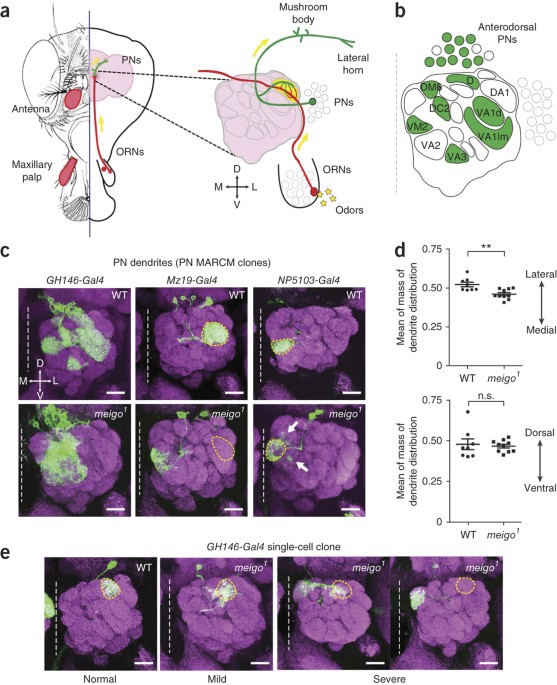
- Select a language for the TTS:
- UK English Female
- UK English Male
- US English Female
- US English Male
- Australian Female
- Australian Male
- Language selected: (auto detect) - EN
Play all audios:
ABSTRACT Neural circuit assembly requires precise dendrite and axon targeting. We identified an evolutionarily conserved endoplasmic reticulum (ER) protein, Meigo, from a mosaic genetic
screen in _Drosophila melanogaster_. Meigo was cell-autonomously required in olfactory receptor neurons and projection neurons to target their axons and dendrites to the lateral antennal
lobe and to refine projection neuron dendrites into individual glomeruli. Loss of Meigo induced an unfolded protein response and reduced the amount of neuronal cell surface proteins,
including Ephrin. Ephrin overexpression specifically suppressed the projection neuron dendrite refinement defect present in _meigo_ mutant flies, and _ephrin_ knockdown caused a similar
projection neuron dendrite refinement defect. Meigo positively regulated the level of Ephrin _N_-glycosylation, which was required for its optimal function _in vivo_. Thus, Meigo, an
ER-resident protein, governs neuronal targeting specificity by regulating ER folding capacity and protein _N_-glycosylation. Furthermore, Ephrin appears to be an important substrate that
mediates Meigo's function in refinement of glomerular targeting. Access through your institution Buy or subscribe This is a preview of subscription content, access via your institution
ACCESS OPTIONS Access through your institution Subscribe to this journal Receive 12 print issues and online access $209.00 per year only $17.42 per issue Learn more Buy this article *
Purchase on SpringerLink * Instant access to full article PDF Buy now Prices may be subject to local taxes which are calculated during checkout ADDITIONAL ACCESS OPTIONS: * Log in * Learn
about institutional subscriptions * Read our FAQs * Contact customer support SIMILAR CONTENT BEING VIEWED BY OTHERS COMBINATORIAL SELECTIVE ER-PHAGY REMODELS THE ER DURING NEUROGENESIS
Article Open access 01 March 2024 ENDOCYTOSIS RESTRICTS DENDRITE BRANCHING VIA REMOVING ECTOPICALLY LOCALIZED BRANCHING LIGANDS Article Open access 07 November 2024 ENDOCYTOSIS IN THE AXON
INITIAL SEGMENT MAINTAINS NEURONAL POLARITY Article Open access 17 August 2022 REFERENCES * Mumm, J.S. et al. _In vivo_ imaging reveals dendritic targeting of laminated afferents by
zebrafish retinal ganglion cells. _Neuron_ 52, 609–621 (2006). CAS PubMed PubMed Central Google Scholar * Vrieseling, E. & Arber, S. Target-induced transcriptional control of
dendritic patterning and connectivity in motor neurons by the ETS gene _Pea3_. _Cell_ 127, 1439–1452 (2006). CAS PubMed Google Scholar * Jefferis, G.S. & Hummel, T. Wiring specificity
in the olfactory system. _Semin. Cell Dev. Biol._ 17, 50–65 (2006). PubMed Google Scholar * Spletter, M.L. et al. Lola regulates _Drosophila_ olfactory projection neuron identity and
targeting specificity. _Neural Dev._ 2, 14 (2007). PubMed PubMed Central Google Scholar * Komiyama, T., Johnson, W., Luo, L. & Jefferis, G. From lineage to wiring specificity. POU
domain transcription factors control precise connections of _Drosophila_ olfactory projection neurons. _Cell_ 112, 157–167 (2003). CAS PubMed Google Scholar * Jefferis, G.S. et al.
Developmental origin of wiring specificity in the olfactory system of _Drosophila_. _Development_ 131, 117–130 (2004). CAS PubMed Google Scholar * Komiyama, T., Sweeney, L., Schuldiner,
O., Garcia, K. & Luo, L. Graded expression of semaphorin-1a cell-autonomously directs dendritic targeting of olfactory projection neurons. _Cell_ 128, 399–410 (2007). CAS PubMed Google
Scholar * Sweeney, L.B. et al. Secreted semaphorins from degenerating larval ORN axons direct adult projection neuron dendrite targeting. _Neuron_ 72, 734–747 (2011). CAS PubMed PubMed
Central Google Scholar * Zhu, H. & Luo, L. Diverse functions of N-cadherin in dendritic and axonal terminal arborization of olfactory projection neurons. _Neuron_ 42, 63–75 (2004). CAS
PubMed Google Scholar * Hong, W. et al. Leucine-rich repeat transmembrane proteins instruct discrete dendrite targeting in an olfactory map. _Nat. Neurosci._ 12, 1542–1550 (2009). CAS
PubMed PubMed Central Google Scholar * Zhu, H. et al. Dendritic patterning by Dscam and synaptic partner matching in the _Drosophila_ antennal lobe. _Nat. Neurosci._ 9, 349–355 (2006).
CAS PubMed Google Scholar * Hong, W., Mosca, T. & Luo, L. Teneurins instruct synaptic partner matching in an olfactory map. _Nature_ 484, 201–207 (2012). CAS PubMed PubMed Central
Google Scholar * Ron, D. & Walter, P. Signal integration in the endoplasmic reticulum unfolded protein response. _Nat. Rev. Mol. Cell Biol._ 8, 519–529 (2007). CAS PubMed Google
Scholar * Cudna, R.E. & Dickson, A.J. Endoplasmic reticulum signaling as a determinant of recombinant protein expression. _Biotechnol. Bioeng._ 81, 56–65 (2003). CAS PubMed Google
Scholar * Schröder, M. & Kaufman, R.J. ER stress and the unfolded protein response. _Mutat. Res._ 569, 29–63 (2005). PubMed Google Scholar * Ryoo, H.D., Domingos, P., Kang, M. &
Steller, H. Unfolded protein response in a _Drosophila_ model for retinal degeneration. _EMBO J._ 26, 242–252 (2007). CAS PubMed Google Scholar * Souid, S., Lepesant, J. & Yanicostas,
C. The _xbp-1_ gene is essential for development in _Drosophila_. _Dev. Genes Evol._ 217, 159–167 (2007). CAS PubMed Google Scholar * Haecker, A. et al. Wollknauel is required for embryo
patterning and encodes the _Drosophila_ ALG5 UDP-glucose:dolichyl-phosphate glucosyltransferase. _Development_ 135, 1745–1749 (2008). CAS PubMed Google Scholar * Dejima, K. et al. The
ortholog of human solute carrier family 35 member B1 (UDP-galactose transporter-related protein 1) is involved in maintenance of ER homeostasis and essential for larval development in
_Caenorhabditis elegans_. _FASEB J._ 23, 2215–2225 (2009). CAS PubMed PubMed Central Google Scholar * Chihara, T., Luginbuhl, D. & Luo, L. Cytoplasmic and mitochondrial protein
translation in axonal and dendritic terminal arborization. _Nat. Neurosci._ 10, 828–837 (2007). CAS PubMed Google Scholar * Tanaka, N.K., Awasaki, T., Shimada, T. & Ito, K.
Integration of chemosensory pathways in the _Drosophila_ second-order olfactory centers. _Curr. Biol._ 14, 449–457 (2004). CAS PubMed Google Scholar * Newsome, T.P., Asling, B. &
Dickson, B. Analysis of _Drosophila_ photoreceptor axon guidance in eye-specific mosaics. _Development_ 127, 851–860 (2000). CAS PubMed Google Scholar * Kobayashi, T., Sleeman, J.,
Coughtrie, M. & Burchell, B. Molecular and functional characterization of microsomal UDP-glucuronic acid uptake by members of the nucleotide sugar transporter (NST) family. _Biochem. J._
400, 281–289 (2006). CAS PubMed PubMed Central Google Scholar * Komiyama, T., Carlson, J. & Luo, L. Olfactory receptor neuron axon targeting: intrinsic transcriptional control and
hierarchical interactions. _Nat. Neurosci._ 7, 819–825 (2004). CAS PubMed Google Scholar * Khanna, M.R., Stanley, B. & Thomas, G. Towards a membrane proteome in _Drosophila_: a method
for the isolation of plasma membrane. _BMC Genomics_ 11, 302 (2010). PubMed PubMed Central Google Scholar * Papoulas, O., Hays, T. & Sisson, J. The golgin Lava lamp mediates
dynein-based Golgi movements during _Drosophila_ cellularization. _Nat. Cell Biol._ 7, 612–618 (2005). CAS PubMed Google Scholar * Ishida, N. & Kawakita, M. Molecular physiology and
pathology of the nucleotide sugar transporter family (SLC35). _Pflugers Arch._ 447, 768–775 (2004). CAS PubMed Google Scholar * Goto, S. et al. UDP-sugar transporter implicated in
glycosylation and processing of Notch. _Nat. Cell Biol._ 3, 816–822 (2001). CAS PubMed Google Scholar * Lüders, F. et al. Slalom encodes an adenosine 3′-phosphate 5′-phosphosulfate
transporter essential for development in _Drosophila_. _EMBO J._ 22, 3635–3644 (2003). PubMed PubMed Central Google Scholar * Selva, E.M. et al. Dual role of the fringe connection gene in
both heparan sulphate and fringe-dependent signaling events. _Nat. Cell Biol._ 3, 809–815 (2001). CAS PubMed Google Scholar * Ishikawa, H.O. et al. Two pathways for importing GDP-fucose
into the endoplasmic reticulum lumen function redundantly in the _O_-fucosylation of Notch in _Drosophila_. _J. Biol. Chem._ 285, 4122–4129 (2010). CAS PubMed Google Scholar * Lin, Y.R.,
Reddy, B. & Irvine, K. Requirement for a core 1 galactosyltransferase in the _Drosophila_ nervous system. _Dev. Dyn._ 237, 3703–3714 (2008). CAS PubMed PubMed Central Google Scholar
* Repnikova, E. et al. Sialyltransferase regulates nervous system function in _Drosophila_. _J. Neurosci._ 30, 6466–6476 (2010). CAS PubMed PubMed Central Google Scholar * Lin, X. &
Perrimon, N. Dally cooperates with _Drosophila_ Frizzled 2 to transduce Wingless signaling. _Nature_ 400, 281–284 (1999). CAS PubMed Google Scholar * Takei, Y., Ozawa, Y., Sato, M.,
Watanabe, A. & Tabata, T. Three _Drosophila_ EXT genes shape morphogen gradients through synthesis of heparan sulfate proteoglycans. _Development_ 131, 73–82 (2004). CAS PubMed Google
Scholar * Kamimura, K. et al. Specific and flexible roles of heparan sulfate modifications in _Drosophila_ FGF signaling. _J. Cell Biol._ 174, 773–778 (2006). CAS PubMed PubMed Central
Google Scholar * Léonard, R. et al. The _Drosophila_ fused lobes gene encodes an _N_-acetylglucosaminidase involved in _N_-glycan processing. _J. Biol. Chem._ 281, 4867–4875 (2006). PubMed
Google Scholar * Nakanishi, H. et al. Hut1 proteins identified in _Saccharomyces cerevisiae_ and _Schizosaccharomyces pombe_ are functional homologues involved in the protein-folding
process at the endoplasmic reticulum. _Yeast_ 18, 543–554 (2001). CAS PubMed Google Scholar * Hollien, J. & Weissman, J.S. Decay of endoplasmic reticulum-localized mRNAs during the
unfolded protein response. _Science_ 313, 104–107 (2006). CAS PubMed Google Scholar * Murray, J.I. et al. Diverse and specific gene expression responses to stresses in cultured human
cells. _Mol. Biol. Cell_ 15, 2361–2374 (2004). CAS PubMed PubMed Central Google Scholar * Iwawaki, T., Akai, R., Kohno, K. & Miura, M. A transgenic mouse model for monitoring
endoplasmic reticulum stress. _Nat. Med._ 10, 98–102 (2004). CAS PubMed Google Scholar * Elefant, F. & Palter, K. Tissue-specific expression of dominant negative mutant _Drosophila_
HSC70 causes developmental defects and lethality. _Mol. Biol. Cell_ 10, 2101–2117 (1999). CAS PubMed PubMed Central Google Scholar * Iwai, Y. et al. Axon patterning requires DN-cadherin,
a novel neuronal adhesion receptor, in the _Drosophila_ embryonic CNS. _Neuron_ 19, 77–89 (1997). CAS PubMed Google Scholar * Chen, C.H. et al. A synthetic maternal-effect selfish
genetic element drives population replacement in _Drosophila_. _Science_ 316, 597–600 (2007). CAS PubMed Google Scholar * Lehrman, M.A. Stimulation of _N_-linked glycosylation and
lipid-linked oligosaccharide synthesis by stress responses in metazoan cells. _Crit. Rev. Biochem. Mol. Biol._ 41, 51–75 (2006). CAS PubMed Google Scholar * Toth, J. et al. Crystal
structure of an ephrin ectodomain. _Dev. Cell_ 1, 83–92 (2001). CAS PubMed Google Scholar * Tien, A.C. et al. Ero1L, a thiol oxidase, is required for Notch signaling through cysteine
bridge formation of the Lin12-Notch repeats in _Drosophila melanogaster_. _J. Cell Biol._ 182, 1113–1125 (2008). CAS PubMed PubMed Central Google Scholar * Reyes, F. et al. The
nucleotide sugar transporters AtUTr1 and AtUTr3 are required for the incorporation of UDP-glucose into the endoplasmic reticulum, are essential for pollen development and are needed for
embryo sac progress in _Arabidopsis thaliana_. _Plant J._ 61, 423–435 (2010). CAS PubMed Google Scholar * Cutforth, T. et al. Axonal ephrin-As and odorant receptors: coordinate
determination of the olfactory sensory map. _Cell_ 114, 311–322 (2003). CAS PubMed Google Scholar * Mosca, T.J., Hong, W., Dani, V., Favaloro, V. & Luo, L. Trans-synaptic Teneurin
signaling in neuromuscular synapse organization and target choice. _Nature_ 484, 237–241 (2012). CAS PubMed PubMed Central Google Scholar * Lee, T. & Luo, L. Mosaic analysis with a
repressible cell marker for studies of gene function in neuronal morphogenesis. _Neuron_ 22, 451–461 (1999). CAS PubMed Google Scholar * Wu, J.S. & Luo, L. A protocol for mosaic
analysis with a repressible cell marker (MARCM) in _Drosophila_. _Nat. Protoc._ 1, 2583–2589 (2006). CAS PubMed Google Scholar * Yamamoto-Hino, M. et al. Cisterna-specific localization of
glycosylation-related proteins to the Golgi apparatus. _Cell Struct. Funct._ 37, 55–63 (2012). CAS PubMed Google Scholar * Bossing, T. & Brand, A. Dephrin, a transmembrane ephrin
with a unique structure, prevents interneuronal axons from exiting the _Drosophila_ embryonic CNS. _Development_ 129, 4205–4218 (2002). CAS PubMed Google Scholar Download references
ACKNOWLEDGEMENTS We thank J.B. Thomas, Bloomington and the Kyoto _Drosophila_ Stock Center for fly stocks, A.H. Brand (University of Cambridge) for the Ephrin antibody and fly stocks, S.
Goto (Rikkyo University) for the dGLG1 (120 kDa) antibody, C. Field (Harvard University) for the Lava Lamp antibody, T. Uemura (Kyoto University) for the _UAS-DNcadherin_ plasmid, H.D. Ryoo
(New York University) and P.M. Domingos (Instituto de Tecnologia Química e Biológica) for xbp1:EGFP-related reagents and the Hsc3 antibody, C.-H. Chen for advice on constructing shRNAs, G.
Thomas and M. Khanna for advice on performing OptiPrep density gradient centrifugation, and all of the members of the Miura and Luo laboratories for comments on this study. We especially
thank T. Mosca for improving the manuscript and M. Okumura and T.C. for the blind test. L.L. is funded by the Howard Hughes Medical Institute. This work was supported by grants from the
Ministry of Education, Culture, Sports, Science and Technology in Japan to M.M. and T.C., the Japan Society for the Promotion of Science to S.U.S., M.M. and T.C., the Japan Science and
Technology Agency to M.M. and T.C., and the US National Institutes of Health (R01 DC005982) to L.L. AUTHOR INFORMATION AUTHORS AND AFFILIATIONS * Department of Genetics, Graduate School of
Pharmaceutical Sciences, University of Tokyo, Tokyo, Japan Sayaka U Sekine, Shuka Haraguchi, Kinhong Chao, Tomoko Kato, Masayuki Miura & Takahiro Chihara * Howard Hughes Medical
Institute and Department of Biology, Stanford University, Stanford, California, USA Liqun Luo * Core Research for Evolutional Science and Technology, Japan Science and Technology Agency,
Tokyo, Japan Masayuki Miura * Precursory Research for Embryonic Science and Technology, Japan Science and Technology Agency, Tokyo, Japan Takahiro Chihara Authors * Sayaka U Sekine View
author publications You can also search for this author inPubMed Google Scholar * Shuka Haraguchi View author publications You can also search for this author inPubMed Google Scholar *
Kinhong Chao View author publications You can also search for this author inPubMed Google Scholar * Tomoko Kato View author publications You can also search for this author inPubMed Google
Scholar * Liqun Luo View author publications You can also search for this author inPubMed Google Scholar * Masayuki Miura View author publications You can also search for this author
inPubMed Google Scholar * Takahiro Chihara View author publications You can also search for this author inPubMed Google Scholar CONTRIBUTIONS S.U.S. performed most of the experiments and
analyzed the data. S.H., K.C. and T.K. assisted in some experiments. T.C. supervised the project. S.U.S. and T.C. wrote the paper with feedback from L.L. and M.M. CORRESPONDING AUTHOR
Correspondence to Takahiro Chihara. ETHICS DECLARATIONS COMPETING INTERESTS The authors declare no competing financial interests. SUPPLEMENTARY INFORMATION SUPPLEMENTARY TEXT AND FIGURES
Supplementary Figures 1–7 and Supplementary Tables 1–3 (PDF 3706 kb) RIGHTS AND PERMISSIONS Reprints and permissions ABOUT THIS ARTICLE CITE THIS ARTICLE Sekine, S., Haraguchi, S., Chao, K.
_et al._ Meigo governs dendrite targeting specificity by modulating Ephrin level and _N_-glycosylation. _Nat Neurosci_ 16, 683–691 (2013). https://doi.org/10.1038/nn.3389 Download citation *
Received: 15 February 2013 * Accepted: 01 April 2013 * Published: 28 April 2013 * Issue Date: June 2013 * DOI: https://doi.org/10.1038/nn.3389 SHARE THIS ARTICLE Anyone you share the
following link with will be able to read this content: Get shareable link Sorry, a shareable link is not currently available for this article. Copy to clipboard Provided by the Springer
Nature SharedIt content-sharing initiative








